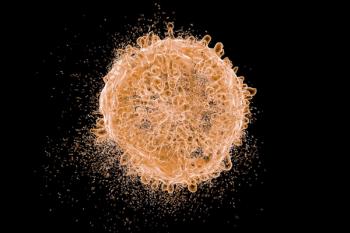
- ONCOLOGY Vol 10 No 10
- Volume 10
- Issue 10
New Clues To Cancer Growth Discovered
Scientists searching for molecular clues to cancer have produced a detailed picture showing how a key protein blocks a central promoter of cell growth involved in virtually all human cancers. The discovery sets the stage for developing drugs to mimic the protein, called p27, with the hope of halting the uncontrolled cell division that ultimately leads to the formation of tumors.
Scientists searching for molecular clues to cancer have produceda detailed picture showing how a key protein blocks a centralpromoter of cell growth involved in virtually all human cancers.The discovery sets the stage for developing drugs to mimic theprotein, called p27, with the hope of halting the uncontrolledcell division that ultimately leads to the formation of tumors.
The three-dimensional image, produced in atom-by-atom detail usinga combination of x-rays and crystals, was published in the July25th issue of Nature by a team of researchers at Memorial Sloan-KetteringCancer Center in New York City led by Nikola P. Pavletich, phd.The research is supported by the NIH and the Howard Hughes MedicalInstitute.
Cell division in many tissues is regulated by the p27 protein,which binds to and inhibits enzymes called cyclin-dependent kinases(CDKs). The crystal structure reveals in intimate detail how p27paralyzes CDKs, thereby arresting the cell cycle.
Cyclin-dependent kinases are so crucial to cell division thatcells--even those that are cancerous--will not multiply withoutthem. Thus, the role of CDKs in tumor growth is a main focus ofcancer research, says Joan Massagué, phd, Program Chairmanfor Cell Biology at Memorial Sloan-Kettering, and one of the paper'sauthors.
"Now that we understand exactly how p27 attaches to CDKsto halt the cell cycle, it may be possible to design or searchfor innovative cancer drugs that work in the same way," saysDr. Massagué, whose laboratory was the first to purifyand clone p27 in 1994.
Research Has Broad Implications
The researchers' high-tech picture also is likely to have broadimplications for other inhibitory proteins in the p27 family,such as p21 and p57. "We expect these proteins, which arestructurally very similar to p27, to bind to CDKs in almost thesame way as p27," says Dr. Massagué. "This workis important because it establishes a general principle by whichan entire family of inhibitors will block cell growth."
Under normal, healthy conditions, these inhibitors keep cell growthin check as part of a universal pathway that, when altered bygenetic mutations, leads to cancer. "What is remarkable isthat this pathway, at one step or another, is crippled in manycancers," Dr. Massagué says.
Researchers have known for years that p27 exerts its inhibitoryeffect by binding to CDKs. Cyclin-dependent kinases are activatedwhen they bind with cyclins. When a cell is ready to divide, cyclinslatch onto CDKs, and the resulting complex activates other enzymesto copy cells' DNA.
Now, by using a sophisticated technique called x-ray crystallography,Drs. Pavletich and Massagué and their colleagues have shownexactly how p27 attaches to the cyclin-CDK complex. The researchersbombarded crystals containing millions of copies of the p27-cyclin-CDKcomplex with intense x-rays directed from many different angles.They then used an electronic detector to gather information fromx-rays that ricocheted off the crystals. A powerful computer analyzedthe data, and the researchers used the resulting information topiece together the molecular structure.
The crystal structure reveals that p27 interacts with both membersof the cyclin-kinase complex, in this case cyclin A and CDK2 (see
In recent years, scientists at Memorial Sloan-Kettering have focusedtheir efforts on elucidating the biologic and chemical controlsthat govern the reproduction of individual cells. In 1994, inScience, Dr. Pavletich reported using x-ray crystallography toidentify the atomic structure of p53, a protein produced by agene involved in triggering about half of all cancers. The p53protein halts cell division by activating the p21 cell cycle-inhibitorprotein.
Then in 1995, Drs. Pavletich and Massagué and their colleaguesalso used x-ray crystallography to identify one type of cyclin-CDKcomplex, which is one of the targets of the p2l and p27 inhibitors.This report was published in Nature.
The team now plans to use x-ray crystallography to reveal howanother class of cell cycle-inhibitors, among them p15 and p16,binds to cyclin-CDK complexes to halt cell division.
Articles in this issue
about 29 years ago
New Cancer Gene Marker Could Help Tailor Chemotherapy for Breast Cancerabout 29 years ago
Cigarette Smoking Among Adults--United States, 1994about 29 years ago
Survey Results: Kicking the Habit Tough for US Tobacco Farmersabout 29 years ago
Nursing Challenges of Caring for Patients with HIV-Related Malignanciesabout 29 years ago
Possible New Approach to Preventing Chemotherapy Drug Resistanceabout 29 years ago
Genetic Tests Further Complicate Ovarian Cancer ControversiesNewsletter
Stay up to date on recent advances in the multidisciplinary approach to cancer.





